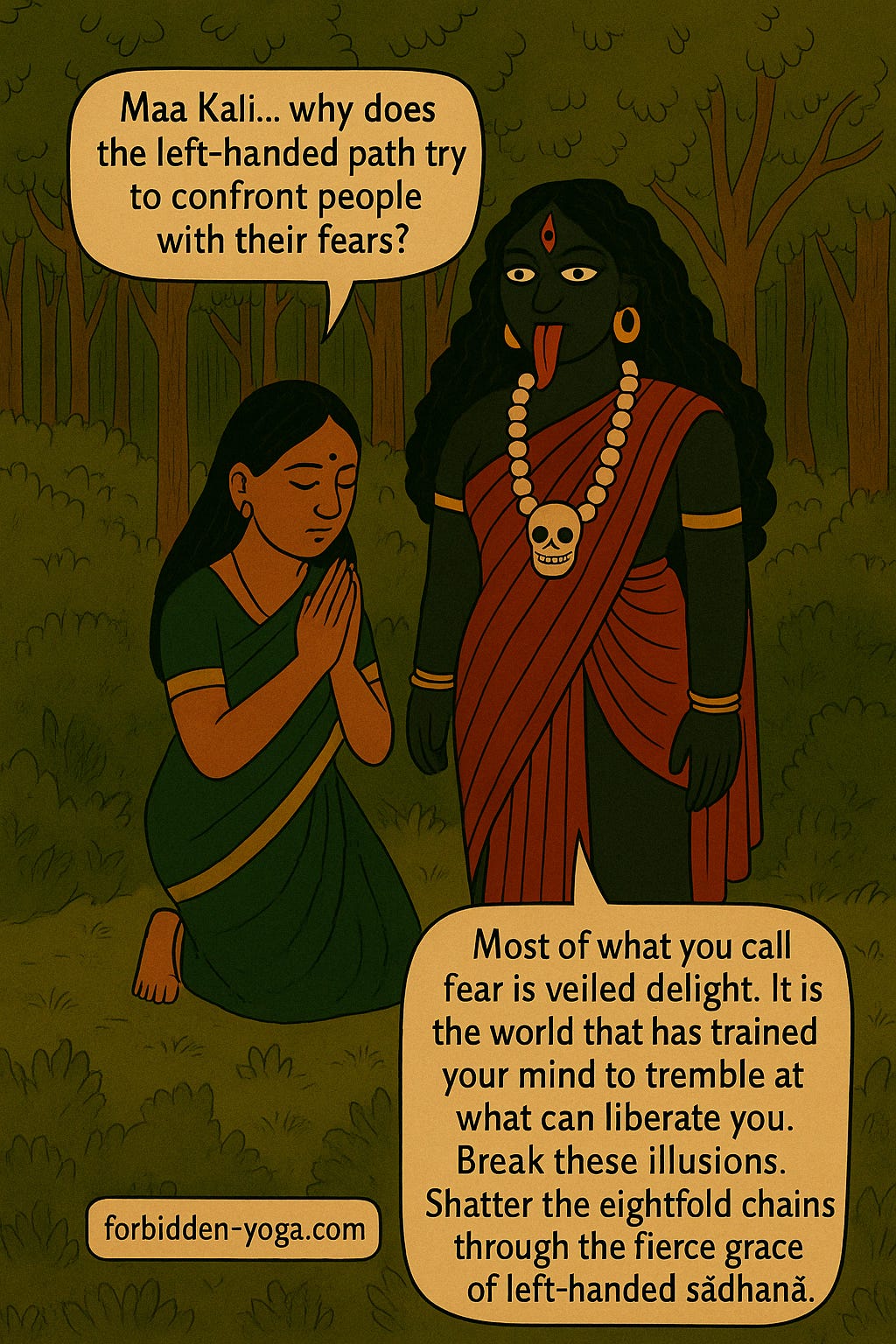The Eight Limitations of Man According to the Kularṇava Tantra
Transgression, Bondage, and Liberation in Left-Handed Tantra
In the esoteric world of Tantric India, few texts evoke as much power and provocation as the Kularṇava Tantra—a medieval Śākta scripture held sacred by practitioners of the left-hand path (Vāmācāra). This scripture does not speak to the masses. It speaks to the few who are willing to stand barefoot in the burning grounds of their own minds.
It is in this text that we find a now-famous listing of the eight limitations (pāśas)—psychic fetters that hold the soul in bondage. These limitations are not external enemies. They are internal knots. The Kularṇava Tantra says clearly: “Hatred (dveṣa), doubt, fear (bhaya), shame (lajjā), disgust (ghṛṇā), family attachment (kula), habit (śīla), and caste (varṇa)—these are the eight bonds. One who is bound by these is a paśu [an animalistic being]; one who is free of these is Śiva.”
These are not metaphors. In the left-handed Kaula tradition, these eight bonds are to be confronted directly through lived ritual acts—often transgressive, always transformative.
Origins of the Kularṇava Tantra
The Kularṇava Tantra (Sanskrit: कुलार्णव तन्त्र) is considered a key textual source of Kaula Tantra. Likely composed between the 11th and 13th centuries CE, it emerged from the Śākta traditions of Eastern India—particularly Bengal and Odisha—where cremation-ground sādhanas, goddess worship, and yogic eroticism flourished. It is a dialogue between Śiva and Devī, and despite its cryptic, initiatory style, it became a cornerstone for the Kaula school, outlining not only doctrines but also ritual practice and the role of the guru.
The Kularṇava defines the Kaula path as one more dangerous than walking on a razor’s edge or holding a tiger by the neck:
“Walking on the razor’s edge of a sword, holding a tiger by the neck, or draping a serpent on one’s body—these are easier than faithfully following the Kula path.” (Kularṇava Tantra 2.122)
It is in this spirit that the eight pāśas are presented—not merely as philosophical defects but as initiatory gates, each to be torn open with ritual fire and personal confrontation.
The Eight Bonds (Aṣṭa-Pāśa)
Dveṣa (Hatred)
This is the mind’s refusal. The active rejection of persons, forms, ideas. In Kaula practice, the sādhaka may be asked to ritually praise what he despises, or to worship the enemy. This isn’t moral therapy. It’s psychic inversion.Saṁśaya (Doubt)
Not intellectual skepticism—but paralyzing doubt in the path, the guru, the Self. The remedy? Acts of irreversible commitment. Obedience in the face of fear. Guru-ordained acts that defy logic and pierce through hesitation.Bhaya (Fear)
Fear is confronted literally. Rituals in cemeteries (śmaśāna-sādhana), sleeping beside corpses, offering liquor to blood-smeared deities. Fear is not managed—it is consumed.
Lajjā (Shame)
Erotic rites in the presence of others. Public nakedness. The loss of face, family name, gender identity. Shame is used as a razor to strip off the social skin.
Ghṛṇā (Disgust)
Meat, menstrual blood, spit, excrement. These are not shocking for shock’s sake. They are tools. Disgust is an armor; Tantra tears it off.
Kula (Family Attachment)
This is deeper than missing home. It’s the entire web of obligations and emotional entrapments that bind one to lineage, clan, and inherited duty. The Kaula sādhaka cuts this cord ritually—with acts that would terrify a Brahmin father.Śīla (Habit/Morality)
Śīla here refers not to discipline but to habitual conduct—the internal autopilot of “good behavior.” Left-handed rites reverse all habits: you eat what you were told was filthy, sleep where you were told was haunted, love what you were told to fear.Varṇa (Caste/Identity)
This is not just about Indian caste. It includes race, gender, class, nation. In cakrapūjā, Kaula rituals often include partners from taboo groups: low caste, different religion, socially outlawed persons. Every time a boundary is crossed, a false identity is peeled away.
Liberation by Breaking Limits
The Kularṇava Tantra does not suggest avoiding the world. It suggests diving into it with radical clarity, under the guidance of a true guru. The text says:
“By those very substances which cause downfall, attainment (siddhi) is taught.” (Kularṇava Tantra 5.48)
This is the core of left-hand Tantra. Wine, meat, sex, filth, cemeteries—when entered ritualistically, with consecration and awareness—become weapons against conditioning. The pāśas are not sins; they are limitations. And limitation, in Tantra, is the only sin.
Contemporary Implications
For the modern practitioner, especially those engaging in Left-Handed Yoga systems, the Kularṇava’s message remains urgently relevant. The eight bonds are not medieval relics. They show up in every conversation with a conservative parent, in every reaction of moral superiority, in every private shudder of shame.
To walk this path today does not necessarily mean sleeping on corpses—but it does mean identifying one’s deepest taboo and walking straight into it. This may be psychological, sexual, social, or spiritual. The path is not safe—but it is sacred.
A Final Thought
The eight pāśas are not to be resolved—they are to be destroyed. What remains is the Kaula adept: naked, unbound, fearless.
In the words of the Kularṇava Tantra,
“One who is free of these bonds is Śiva.”
And Śiva, in Kaula Tantra, is not the yogi who escapes the world, but the madman who dances inside its burning center.









